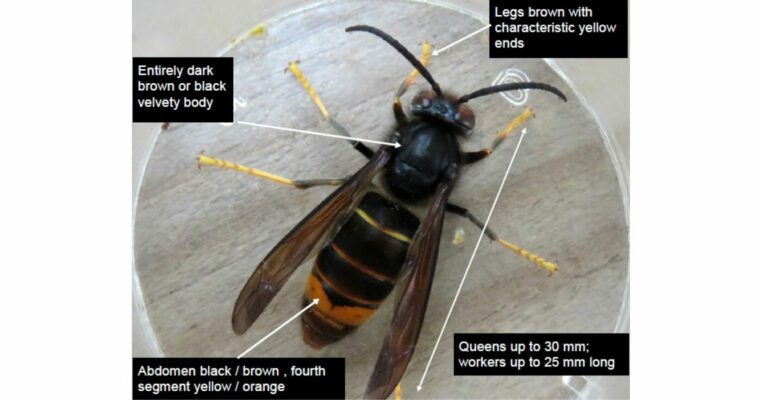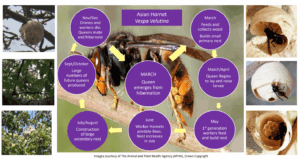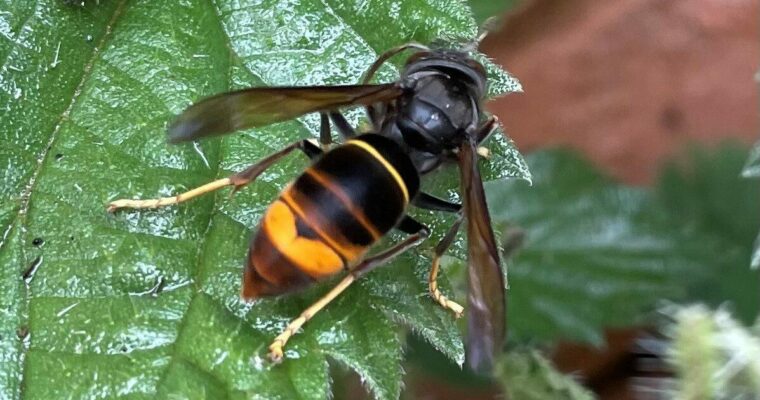The Kent Downs National Landscape is known and loved for its beautiful countryside, rich in biodiversity, and long farming traditions. But this special landscape now faces a new challenge – from the invasive Asian Hornet (Vespa velutina), a species first spotted in the UK in 2016 after arriving from France.
Asian hornets, also known as yellow-legged hornets, are serious predators of our native pollinators – like butterflies, honeybees, and bumblebees – which are essential for thriving wildflowers, crops and food production. Without action, the impact on nature and farming could be severe.
Sightings tend to peak from late summer, so now’s the time to stay alert. Please report any suspected sightings using the Asian Hornet Watch App. Acting early helps us get ahead of this invasive species – especially before August and September, when new females and future queens begin to emerge.
Why do Asian Hornets matter
A single Asian Hornet nest can kill more than 11kg of insects in a single season – that’s tens of thousands of pollinators lost, equivalent in weight to a car tyre!
In other parts of Europe, their arrival has led to huge declines in native insects and honeybee losses of up to 80%, with knock-on effects for wildlife, food growing, and rural economies. It’s a wake-up call- and here in the Kent Downs we’re determined to act early.
How to spot an Asian Hornet

Being able to tell an Asian Hornet apart from other insects is key to tackling the problem. Here’s what to look for:
- Size: Workers are around 25mm long, queens slightly longer.
- Body colour: A mostly black body with a distinctive orange band near the tail.
- Legs: The rear legs are yellow – giving the nickname ‘yellow-legged hornet.’
- Head: Dark with a yellow or orange face.
Unlike bees or hoverflies, they appear more streamlined and wasp-like in flight. If you think you’ve seen one, don’t approach it – just note the location and report it on the official UK Asian Hornet Watch app (available on iOS and Android) or through your local bee-keeping group.
What makes Asian Hornets different
To understand how we stop Asian Hornets spreading, it helps to know a little about how they live.
Each year begins with a single queen. She emerges from hibernation in early spring, often from a quiet corner of a shed, garage, or log pile. She starts by building a small starter nest low down, hidden by dense shrubs or undergrowth, and lays the first few of eggs.
By late spring, her first workers hatch. They take over nest-building and foraging, giving the queen time to focus on egg laying. The colony soon outgrows its starter nest and moves to a larger, secondary nest – often high up in trees – by around July time. Some of these can grow to the size of a backpack, housing hundreds of hornets.
The period from mid-summer to early autumn (July to September) is when hornet activity and the threat to native pollinators is at its highest. During this time, hornets hunt intensely, feeding on bees, hoverflies, butterflies, and moths.
As autumn arrives, the colony produces new queens and males. Once they’ve mated, the old nest dies off, while the new queens find safe places to hibernate – and the cycle starts all over again the following spring.

Working together to protect our pollinators
To protect crops and natural heritage of the Kent Downs, we’re working closely with local people, farmers and conservation groups, including Asian Hornet, to monitor and trap Asian Hornets to contain their spread.
We’re coordinating the distribution of selective Asian hornet traps across key locations in the Kent Downs. Landowners will be given clear guidance on how to access and use these traps effectively. By gathering consistent data across the landscape, we aim to build a comprehensive picture of hornet activity and population trends.
Smarter way to trap
We’re working with Asian Hornet Alert to roll out effective, low-impact traps across the Kent Downs – these are being distributed through our partner organisations, rather than directly to the public. While we’re not supplying traps to the public, everyone can still play a vital role by reporting sightings.
These selective traps are designed to target and attract Asian Hornets specifically, allowing native insects to escape unharmed — as demonstrated in the video below, where a native pollinator is able to feed and then exit freely.
They use a specially formulated bait and cost just around £3 per kit – making them affordable and easy to use. Only the bait needs replacing every week to 10 days so they can be reused throughout the season.
After registering your interest here, you’ll be able to collect a free Asian Hornet trap kit from one of our local Hornet Hubs across the Kent Downs:
Where to get a trap kit
A quick note before you visit: You’ll need to fill in our simple online form before picking up a trap kit — that way, we know to expect you and can make sure your kit’s ready. Each Hornet Hub has different opening times, so it’s a good idea to check before making the trip.
- Brockhill Country Park
Thursday: 9am – 12pm
Friday: 9am – 10am
Saturday: 9am – 10am
- Lullingstone Country Park
Monday – Friday 10am – 4.00pm
- Shorne Woods Country Park
Monday – Friday, 10am – 4pm
- Trosley Country Park
Monday – Friday, before 9.30am
- Bore Place
Monday – Friday, 9am – 5pm
- Lenham Community Centre
Monday – Friday, 9am – 1pm
- Brook Rural Museum
Collection by arrangement – please email: conservation@brookruralmuseum.org.uk
If you’d prefer to buy your own trap, you can order directly from Asian Hornet Alert for £3 each (plus postage) by emailing: shopasianhornetalert@gmail.com. Collection by arrangement is also possible.
If you’re setting up a trap, we ask that you register it using the AHA Catch App – this helps us log real-time data and track hornet activity across the region. If you’re not able to use the app, no problem! You can email your trap details and a grid reference (or address) to: secretary@asianhornetalert.org.uk
We’ve already had brilliant support from local residents, farmers, and volunteers – the more people who get involved, the stronger our network becomes. Every trap helps us build a clearer picture of where hornets are active.
Seasonal update – switch to black lids
From late September through the second week of December, we recommend fitting black ‘queen lids’ on your Asian hornet traps. These lids are designed to target emerging queens during this period, helping to reduce the risk of new colonies establishing next spring.
Mapping sightings in real-time
All traps are logged through a central system run by Asian Hornet Alert. Using the AHA Catch App, you can both register traps and submit any hornet sightings. This real-time data helps identify hotspots and track how hornet populations are moving – which is essential for early nest detection and removal.
You can explore confirmed nests across the UK using the APHA BeeBase Map. Just open the map, scroll to the ‘Layers’ tab, and tick ‘yellow-legged hornet nests’ to view recent data.
For the most up-to-date sightings, you can also follow the rolling updates published by the National Bee Unit.
How you can help: spot, snap, report

Your role is simple – but vital. If you think you’ve seen an Asian Hornet:
- Take a clear photo (from a safe distance!)
- Report it via the free Asian Hornet Watch App, or Email alert_nonnative@ceh.ac.uk
- Even if it turns out to be a harmless lookalike, your report adds to the bigger picture. Every sighting we receive helps build the case for faster action and greater protection for our wildlife.
Please don’t attempt to swat, trap, or remove nests yourself. This work must be done by trained volunteers and professionals to keep people – and native species – safe.
The Making Trapping Happen project is made possible thanks to funding from Defra’s Farming In Protected Landscapes programme. Thank you to all the local people, farmers, landowners, and volunteers helping us protect pollinators and wildlife across the Kent Downs.

